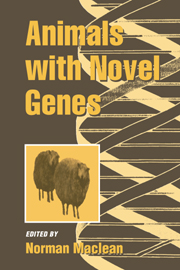1 - Transgenic animals in perspective
Published online by Cambridge University Press: 21 October 2009
Summary
Introduction
What are transgenic animals?
Since the earliest days of animal domestication, people have sought to improve their flocks and herds and companion animals by selective breeding. Although the results of such breeding are impressive, the procedure is by nature slow and to some extent imprecise. So the dream existed that perhaps one could take a more direct hand in stock improvement by recovering the genetic factors involved and adding these selectively to individual animals. The first attempts to do this took place some thirty years ago, but since the methods of DNA purification were suboptimal and methods had not been developed for gene isolation and cloning, complete genomic DNA preparations were used. These were simply mixed with animal eggs or embryos in the hope that transfer might occur, and then the resulting adults were screened for phenotypic features previously present only in the donors. Many of us can remember such experiments being undertaken with DNA from pigmented Ambystoma (the Mexican axolotl), such DNA being added to or injected into albino embryos of this species in the hope that the pigment gene would be transferred. Since that gene was likely to be swamped by the DNA for at least 1 million alternative sequences, one can see with the benefit of hindsight that the odds against success were enormous.
The developments which have now tipped the balance in our favour are chiefly threefold. The first, along with improvements in methods of DNA extraction and purification, was the discovery of restriction enzymes, which made it possible to dissect DNA into manageable fragments of precise length and sequence.
- Type
- Chapter
- Information
- Animals with Novel Genes , pp. 1 - 20Publisher: Cambridge University PressPrint publication year: 1995



